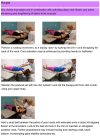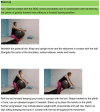Effect of innovative vs. usual care physical therapy in subacute rehabilitation after stroke. A multicenter randomized controlled trial
- PMID: 36407967
- PMCID: PMC9673903
- DOI: 10.3389/fresc.2022.987601
Effect of innovative vs. usual care physical therapy in subacute rehabilitation after stroke. A multicenter randomized controlled trial
Abstract
Background: Research on stroke rehabilitation often addresses common difficulties such as gait, balance or physical activity separately, a fragmentation contrasting the complexity in clinical practice. Interventions aiming for recovery are needed. The purpose of this study was to investigate effects of a comprehensive low-cost physical therapy intervention, I-CoreDIST, vs. usual care on postural control, balance, physical activity, gait and health related quality of life during the first 12 weeks post-stroke.
Methods: This prospective, assessor-masked randomized controlled trial included 60 participants from two stroke units in Norway. Participants, who were randomized to I-CoreDIST (n = 29) or usual care physical therapy (n = 31), received 5 sessions/week when in-patients or 3 sessions/week as out-patients. Primary outcomes were the Trunk Impairment Scale-modified Norwegian version (TISmodNV) and activity monitoring (ActiGraphsWgt3X-BT). Secondary outcomes were the Postural Assessment Scale for Stroke, MiniBesTEST, 10-meter walk test, 2-minute walk test, force-platform measurements and EQ5D-3L. Stroke specific quality of life scale was administered at 12 weeks. Linear regression and non-parametric tests were used for statistical analysis.
Results: Five participants were excluded and seven lost to follow-up, leaving 48 participants in the intention-to-treat analysis. There were no significant between-group effects for primary outcomes: TIS-modNV (p = 0,857); daily average minutes of sedative (p = 0.662), light (p = 0.544) or moderate activity (p = 0.239) and steps (p = 0.288), or secondary outcomes at 12 weeks except for significant improvements on EQ5D-3L in the usual care group. Within-group changes were significant for all outcomes in both groups except for activity levels that were low, EQ5D-3L favoring the usual care group, and force-platform data favoring the intervention group.
Conclusions: Physical therapy treatment with I-CoreDIST improved postural control, balance, physical activity and gait during the first 12 weeks after a stroke but is not superior to usual care.
Keywords: balance; gait; health related quality of life; physical activity; physical therapy; rehabilitation; stroke; trunk control.
© 2022 Sivertsen, Arntzen, Alstadhaug and Normann.
Conflict of interest statement
The authors declare that the research was conducted in the absence of any commercial or financial relationships that could be construed as a potential conflict of interest.
Figures





References
LinkOut - more resources
Full Text Sources

